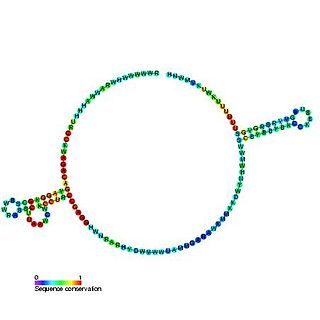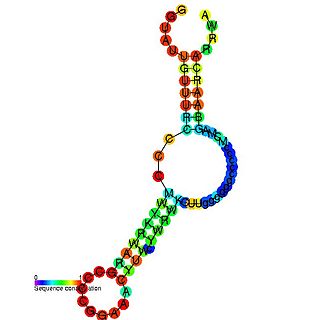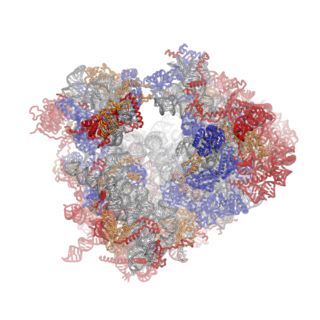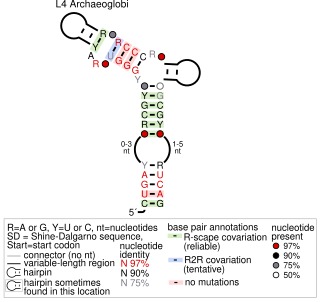
Ribosomal ribonucleic acid (rRNA) is a type of non-coding RNA which is the primary component of ribosomes, essential to all cells. rRNA is a ribozyme which carries out protein synthesis in ribosomes. Ribosomal RNA is transcribed from ribosomal DNA (rDNA) and then bound to ribosomal proteins to form small and large ribosome subunits. rRNA is the physical and mechanical actor of the ribosome that forces transfer RNA (tRNA) and messenger RNA (mRNA) to process and translate the latter into proteins. Ribosomal RNA is the predominant form of RNA found in most cells; it makes up about 80% of cellular RNA despite never being translated into proteins itself. Ribosomes are composed of approximately 60% rRNA and 40% ribosomal proteins by mass.
Diamond–Blackfan anemia (DBA) is a congenital erythroid aplasia that usually presents in infancy. DBA causes low red blood cell counts (anemia), without substantially affecting the other blood components, which are usually normal. This is in contrast to Shwachman–Bodian–Diamond syndrome, in which the bone marrow defect results primarily in neutropenia, and Fanconi anemia, where all cell lines are affected resulting in pancytopenia.

This family is a putative ribosomal protein leader autoregulatory structure found in B. subtilis and other low-GC Gram-positive bacteria. It is located in the 5′ untranslated regions of mRNAs encoding ribosomal proteins L10 and L12 (rplJ-rplL). A Rho-independent transcription terminator structure that is probably involved in regulation is included at the 3′ end.

L13 ribosomal protein leaders are part of the ribosome biogenesis. They are used as an autoregulatory mechanism to control the concentration of ribosomal proteins L13. An experimentally confirmed ribosomal protein leader autoregulatory structure was found in B. subtilis and other low-GC Gram-positive bacteria. It is located in the 5′ untranslated regions of mRNAs encoding the L13-S9 (rplM-rpsI) ribosomal protein operon. A second example were predicted in Bacteroidia with bioinformatic approaches, but the structure of the putative Bacteroidia example is apparently unrelated to the previously established L13 ribosomal protein leader.

S15 Ribosomal protein leaders are part of the ribosome biogenesis. They were used as an autoregulatory mechanism to control the concentration of ribosomal proteins S15. The structure is located in the 5′ untranslated regions of mRNAs encoding ribosomal proteins S15 (rpsO). Multiple distinct structural types of S15 ribosomal protein leaders are known in different organisms.

40S ribosomal protein S19 is a protein that in humans is encoded by the RPS19 gene.

60S ribosomal protein L7 is a protein that in humans is encoded by the RPL7 gene.

60S ribosomal protein L13a is a protein that in humans is encoded by the RPL13A gene.

60S ribosomal protein L8 is a protein that in humans is encoded by the RPL8 gene.

40S ribosomal protein S20 is a protein that in humans is encoded by the RPS20 gene.

40S ribosomal protein S11 is a protein that in humans is encoded by the RPS11 gene.

60S ribosomal protein L30 is a protein that in humans is encoded by the RPL30 gene.
Ribosomal protein S4, Y-linked 2 also known as RPS4Y2 is a protein which in humans is encoded by the RPS4Y2 gene which resides on the Y chromosome.

Ribosomes are a large and complex molecular machine that catalyzes the synthesis of proteins, referred to as translation. The ribosome selects aminoacylated transfer RNAs (tRNAs) based on the sequence of a protein-encoding messenger RNA (mRNA) and covalently links the amino acids into a polypeptide chain. Ribosomes from all organisms share a highly conserved catalytic center. However, the ribosomes of eukaryotes are much larger than prokaryotic ribosomes and subject to more complex regulation and biogenesis pathways. Eukaryotic ribosomes are also known as 80S ribosomes, referring to their sedimentation coefficients in Svedberg units, because they sediment faster than the prokaryotic (70S) ribosomes. Eukaryotic ribosomes have two unequal subunits, designated small subunit (40S) and large subunit (60S) according to their sedimentation coefficients. Both subunits contain dozens of ribosomal proteins arranged on a scaffold composed of ribosomal RNA (rRNA). The small subunit monitors the complementarity between tRNA anticodon and mRNA, while the large subunit catalyzes peptide bond formation.

L25 ribosomal protein leader is a ribosomal protein leader involved in the ribosome biogenesis. It is used as an autoregulatory mechanism to control the concentration of the ribosomal protein L25. Known Examples were predicted in Gammaproteobacteria with bioinformatic approaches. or in Enterobacteria . The structure is located in the 5′ untranslated regions of mRNAs encoding ribosomal protein L25 (rplY).

S10 ribosomal protein leader is a ribosomal protein leader involved in the ribosome biogenesis. It is used as an autoregulatory mechanism to control the concentration of the ribosomal protein S10. Known Examples were predicted in Clostridia or other lineages of Firmicutes with bioinformatic approaches. The structure is located in the 5′ untranslated regions of mRNAs encoding ribosomal proteins S10 (rpsJ), L3 (rplc) and L4 (rplD). There is an uncertainty about the ligand, because of a lack of experimental investigation.

The S4 ribosomal protein leader is a ribosomal protein leader involved in ribosome biogenesis. It is used as an autoregulatory mechanism to control the concentration of the ribosomal protein S4. Two examples of such leaders that use different conserved structures, in Firmicutes and Gammaproteobacteria, have been experimentally confirmed. Four additional S4 ribosomal protein leaders, each with distinct structures, were predicted in various bacteria phyla. In Bacteroidia or Firmicutes, the structure is located in the 5′ untranslated regions of mRNAs encoding ribosomal proteins S4 (rpsD), RNA polymerase alpha subunit (rpoA) and L17 (rplQ). In Clostridia and Gammaproteobacteria, the ribosomal proteins S13 (rpsM) and S11 (rpsK) were also part of the mRNA encoding region.

A S16 ribosomal protein leader is a ribosomal protein leader involved in ribosome biogenesis. It is used as an autoregulatory mechanism to control the concentration of the ribosomal protein S16. Known Examples were predicted in Flavobacteria with bioinformatic approaches. The structure is located in the 5′ untranslated regions of mRNAs encoding ribosomal proteins L16 (rpsP) and the ribosome maturation factor protein (rimM).

S6:S18 ribosomal protein leader is a ribosomal protein leader involved in the ribosome biogenesis. It is used as an autoregulatory mechanism to control the concentration of the ribosomal proteins S6:S18 compplex. An experimentally confirmed example of such a leader occurs in a wide variety of bacteria, though not all phyla. A S6:S18 ribosomal leader was predicted in Chlorobia, and its predicted structure differs from that of the validated S6:S18 ribosomal leader. This structure is located in the 5′ untranslated regions of mRNAs encoding ribosomal proteins rpsF (S6), the Single-strand DNA-binding protein A (ssbA), S18 (rpsR) and L7/L12 (rpll).

An L4 ribosomal protein leader is a ribosomal protein leader involved in ribosome biogenesis. It is used as an autoregulatory mechanism to control the concentration of the ribosomal protein L4. Known Examples were predicted in Archaeoglobi with bioinformatic approaches. The structure is located in the 5′ untranslated regions of mRNAs encoding ribosomal proteins L3 (rplC), L4 (rplD), L23 (rplW) and L2 (rplB).













